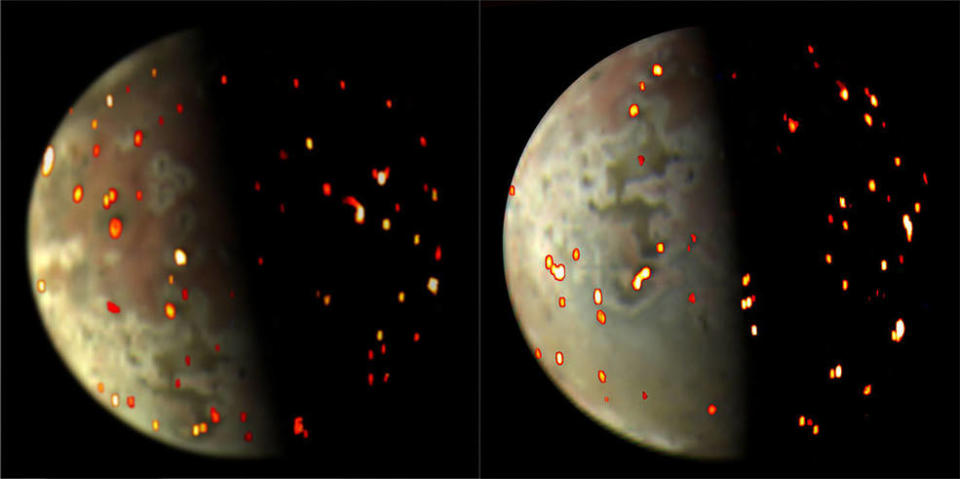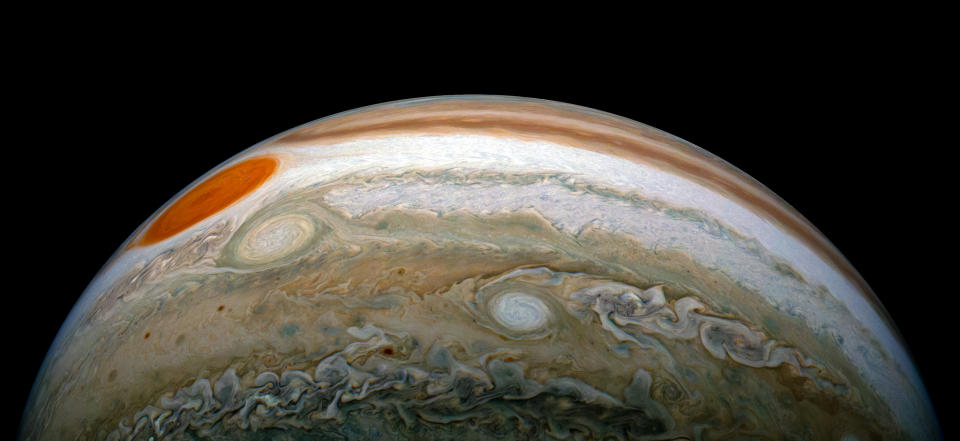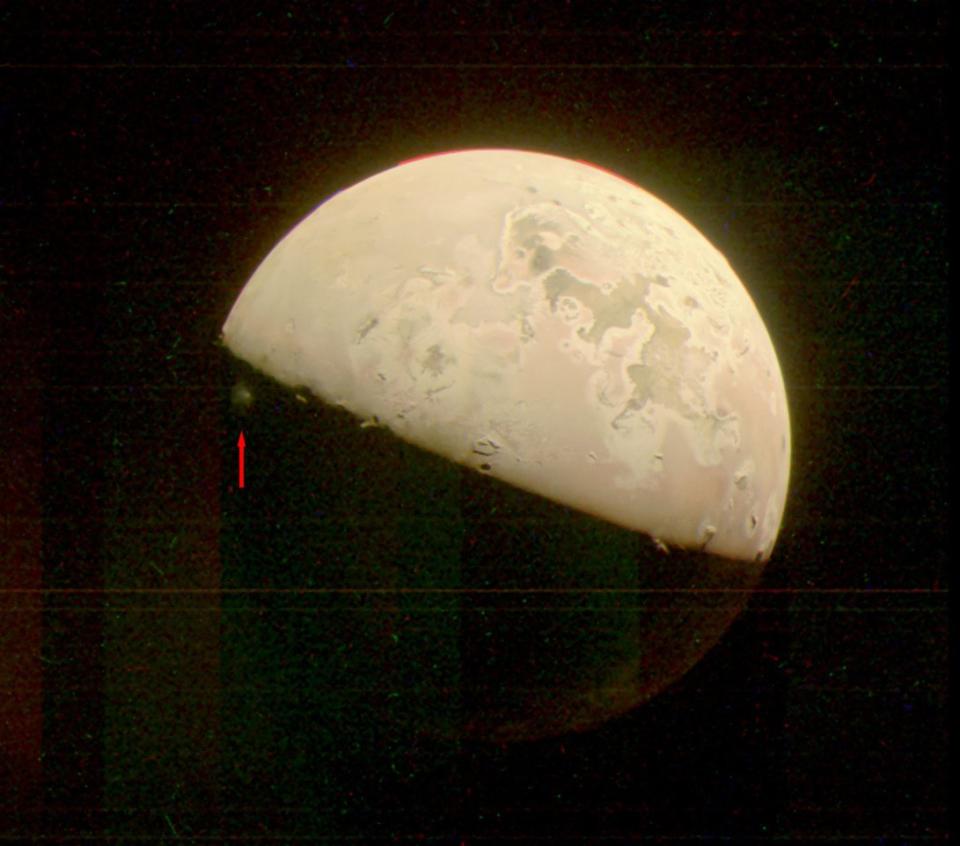NASA’s Juno mission will come closer to Jupiter’s moon Io on Saturday (December 30) than any spacecraft has in about 20 years.
The flyby will take Juno to about 1,500 kilometers from Io, the most volcanic body in the solar system. This allows the spacecraft to view Io in detail while collecting a wealth of hot data. It’s close, but not the closest look ever by a spacecraft: that record belongs to NASA’s Galileo spacecraft, which passed just 181 kilometers (112 miles) above Io’s south pole in 2001.
Juno was launched on August 5, 2011 and reached the gas giant Jupiter, the largest planet in the solar system, on July 4, 2016, after a journey of 2.8 billion kilometers. Since then, the Jupiter orbiter has passed by the gas planet 56 times, collecting data about the gas planet and its moons, and is about to embark on the next one.
“By combining data from this flight with our previous observations, the Juno science team is studying how Io’s volcanoes vary,” Scott Bolton, Southwest Research Institute scientist and Juno principal investigator, said in a statement. “We’re looking for how often they erupt, how bright and hot they are, how the shape of the lava flow changes, and how Io’s activity is related to the flow of charged particles in Jupiter’s magnetosphere.”
Related: Jupiter’s moon Io is covered in active volcanoes. Now we have the first map of it
Now in the third year of its extended mission, with the primary mission ending in July 2021, Juno will fly close to Io again on February 3, 2024, at a distance of about 1,500 km from the volcanic volcano. surface of this Jovian world.
The flybys of Io in December 2023 and February 2024 will add to the wealth of information scientists have collected about Io thanks to Juno, which has monitored volcanic activity from distances ranging from 6,830 miles (11,000 km) to more than 62,100 miles (100,000 km ). During its time in service, NASA’s spacecraft also gave researchers their first images of Io’s north and south poles.

Why explore Jupiter’s ‘tortured moon’ Io?
Io’s surface, which is about the size of Earth’s moon, is littered with hundreds of actively erupting volcanoes that can blow lava tens of kilometers into Jupiter’s moon’s thin, waterless atmosphere.
It is believed that Jupiter’s innermost Galilean satellite, one of Jupiter’s four major moons, Io, is so extremely volcanic due to the gravitational influence of the gas giant planet and that of its three other Galilean moons – Europa, Ganymede and Callisto.
This generates tidal forces so powerful that they can cause Io’s surface to rise and fall as much as 100 meters, causing extreme volcanism.
“With our two short flybys in December and February, Juno will investigate the source of Io’s massive volcanic activity, whether a magma ocean exists beneath its crust, and the importance of Jupiter’s tidal forces, which are ruthlessly squeezing this tortured moon,” Bolton added.
It is necessary to understand Io’s volcanism because it is likely to have an impact on the broader Jovian system. For example, volcanic particles escaping from Io’s atmosphere are thought to become trapped in Jupiter’s magnetic field, forming a hot donut of plasma around the gas giant planet.


How does Juno investigate Io
During the flyby of Io this weekend, all three of Juno’s cameras will be active. The Jovian Infrared Auroral Mapper (JIRAM) will collect information about the volcanic moon’s heat signature and locate volcanoes and calderas on the Jovian moon. Meanwhile, the navigation star camera, the Stellar Reference Unit, will collect the highest resolution images of Io’s volcano-torn surface yet collected.
Last but not least, JunoCam, part of Juno’s toolbox to drive public engagement, will capture full-color visible-light images of the volcanic moon.
JunoCam is designed for just eight flybys of Jupiter, making the images of Io it will collect during this 57th flyby even more remarkable. All three cameras and the Juno spacecraft itself have had to brave and withstand the punishing radiation environment around Jupiter, perhaps the harshest in the solar system other than the Sun, to continue this remarkable science mission. But this punishment is starting to show.
“The cumulative effects of all that radiation have been visible on JunoCam over the past few orbits,” said Juno project manager Ed Hirst. “Photos from the latest flyby show a reduction in the camera’s dynamic range and the appearance of ‘striping’ noise. Our engineering team has been working on solutions to reduce the radiation damage and keep the camera running.”


After Juno’s orbit of Io in February 2024, NASA’s orbiter will fly by Jupiter’s moon on each of its subsequent orbits of Jupiter, but each orbit will then move further away from Io’s volcanic surface.
The first flight after February will take place at an altitude of about 16,500 kilometers above Io, while the last will take the NASA spacecraft to a distance of about 115,000 kilometers from the volcanic moon.
Juno will now also experience periods when Jupiter eclipses the Sun, blocking access to solar energy and causing the planet to experience darkness for the first time since Earth left.
RELATED STORIES:
— A massive, months-long volcanic eruption rocks Jupiter’s moon Io
— See Jupiter’s volcanic moon Io glow red hot in incredible images from NASA’s Juno probe
– Juno: Taking a long look at Jupiter
This is not expected to affect Juno’s operations, and from April 2024 the spacecraft will use these occultation events to help its Gravity Science Experiment investigate the composition of Jupiter’s upper atmosphere and gather information about the planet’s shape and its interior. structure.
Juno’s extended mission to explore the Jovian system will last until September 2025, when NASA says the spacecraft will reach the end of its life and will likely be deliberately crashed into the gas giant’s atmosphere.